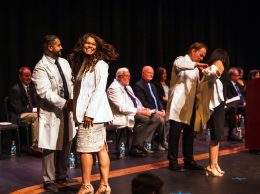Space group took $16M in public funds
IN THIS ARTICLE
- Technology Topic
- Stephen Nellis Author
By Stephen Nellis Friday, June 10th, 2011
The recently dissolved California Space Authority used millions of dollars in federal earmarks and grants to shuffle paper and produce reports with little to show for it.
It also acted as conduit to help secure federal funding for government contractors, including some who wrote checks to the Space Authority.
The Space Authority, based in Santa Maria, was a private nonprofit group designed to bring together California’s space industry. Its major supporters included Lockheed Martin, Boeing, Northrop Grumman and Raytheon. But the nonprofit secured only a few hundred thousand dollars per year from those sources, its leaders say.
The Space Authority’s largest source of funding has been government.
U.S. and California agencies gave it $15.9 million directly during the past 15 years. These governments also tapped the Space Authority to oversee or screen proposals for $106.6 million in additional government spending.
The Space Authority’s board of directors — which includes members from Boeing, Northrop Grumman and Raytheon — voted on June 6 to dissolve the group after it lost a $5 million federal grant and could not secure a $1.6 million earmark to continue its operations.
The nonprofit also failed in its bid to build a proposed $200 million, half-million-square-foot business park and space museum at Vandenberg Air Force Base. The city of Lompoc will try on its own to resurrect the project.
The nonprofit “never made any decisions as to who should get the dollars. We never managed the projects. That was all done by Congress,” said Andrea Seastrand, a former Republican congresswoman who served as the group’s only executive director. Some of the funding went to corporations that weren’t involved in the Space Authority, she said.
The Space Authority’s dissolution raises questions about how the public’s money was spent and what is left to show for it. The largest grant program the Space Authority directly oversaw — a $15 million effort from the Department of Labor to bring together an “innovation corridor” along the California coast — produced only reams of reports and plans that largely have not been put to use.
In addition, a Business Times analysis reveals that the Space Authority acted as a funnel for space projects that Congress eventually approved and that sometimes benefited the nonprofit’s members. Space Authority officials say they followed rules that prohibit using taxpayer dollars for lobbying.
Here is a closer look at how the California Space Authority spent taxpayer dollars.
WIRED got $3 million
One of the largest efforts at the Space Authority was the U.S. Department of Labor’s Workforce Innovation in Regional Economic Development, or WIRED, grant program. Awarded in 2006, the program involved $3 million in federal money given to the Space Authority to distribute $12 million in grants over three years.
The program was broad in scope, aiming to bring together the space industry from the Bay Area to San Diego, with a strip of Inland Empire also included. The projects funded by the grants have names such as “building a learning collaboratory of training and best practices on innovative approaches to partnerships in support of an innovation ecosystem.”
The end result was plans turned over to the state that Seastrand agreed have not been put to much use. She blamed a change in political control in Washington and shifting priorities in Sacramento. “There was a change in administration and they went on their own way,” Seastrand said.
Some supporters of publicly funded economic and workforce development felt that while the Space Authority did a commendable job organizing the program, it yielded little.
“It was really an overreach,” said Bruce Stenslie, now head of the Economic Development Collaborative-Ventura County and a onetime participant in the program. “It ended up being 30 different contracts with 65 different outcomes. I’m not sure there was a single outcome.”
But former board members point to the Department of Labor effort as one of the Space Authority’s lasting accomplishments. “Their WIRED project was an incredible effort to identify innovation,” said Raymond Deutsch, an architect with Westberg & White.
Million-dollar earmark
The Space Authority received an initial $8.5 million in federal money for what is known as the California Space Infrastructure Program. The first step was a two-year study to identify important parts of the Golden State’s space infrastructure that needed upgrades, such as aging rocket-engine test facilities at Edwards Air Force Base.
For four years, the Space Authority received a $1 million per year earmark to oversee the program. In all, it identified and recommended $87.5 million in projects that Congress eventually funded.
One was the Spaceport Arrival and Departure Safety System, a radar system that can track many small objects simultaneously that was demonstrated in 2004 at Edwards Air Force Base. The project was funded through the space infrastructure program, though Space Authority officials could not immediately provide a precise figure for the funding. One of the contractors on the project was JT3, a joint venture co-founded by Raytheon, which gave the Space Authority $5,000 for a “president’s circle” membership.
In addition to Raytheon, the Space Authority got $25,000 from SpaceX and $10,000 each from ATK Space Systems, Boeing, Lockheed Martin and Westberg & White Architects in Santa Maria. It received $5,000 each from AeroJet, Cal Poly San Luis Obispo and Santa Maria-based Quintron.
“If you think they’re going to sell their souls for that amount of money, I don’t know,” Seastrand said.
Officials said the Space Authority’s role in federal contract awards was to solicit project ideas, which could come from any organization, whether or not it was a supporter. The nonprofit then forwarded those to paid, third-party consultants who evaluated and ranked them. Then the Space Authority sent proposals to an advisory committee that sometimes included the Air Force and NASA. Only then were they forwarded to Washington, officials said.
The Space Authority did engage in formal lobbying, such as opposing state legislation that would have taxed satellite television. However, James E. McGlothlin, a Space Authority board member from Quintron, told the Business Times in an email that no taxpayer dollars were used for that purpose. “Federal and state funding restrictions required allocation of dollars to specific funded projects, not advocacy efforts,” McGlothlin wrote.
Space center’s failure
Over the past decade, the group’s major focus was the California Space Center, a proposed 500,000-square-foot complex just outside of the only spaceport on the West Coast at Vandenberg Air Force Base in Santa Barbara County. In January, the Space Authority told the Business Times it was within months of signing a final lease with the Air Force and breaking ground.
But in March, the Space Authority halted those plans. The group said it had determined that the space center would have had to navigate Santa Barbara County’s strict environmental review process, which would have added three to five years of hearings and approvals before construction could start.
Vandenberg officials say they told the Space Authority all along that it would need to seek county permits. “Given that it was a private project, CSA [California Space Authority] was informed by Air Force personnel on various occasions, including early in the actual negotiation talks, that it should consult with the county on permitting requirements,” Jeremy Eggers, a Vandenberg spokesman, told the Business Times in an email.
Seastrand disagreed with that characterization of the talks. “We went after an enhanced use lease [from the Air Force] because we were told it would be quicker. We were told a lot of things,” Seastrand said.
In the wake of the Space Authority’s failure at Vandenberg, it handed the project — which, according to Seastrand, benefited from $2.5 million worth of unpaid volunteer time — to the city of Lompoc. The city is considering trying to build the project on city land near the Lompoc campus of Allan Hancock College.
“The bulk of [the Space Authority’s work] was readily transferable — there really wasn’t much that was lost other than some security stuff that had to be done to build the facility to meet Air Force requirements,” said Lompoc Mayor John Linn.
Related Articles
 Friday, September 16th, 2022
Friday, September 16th, 2022











